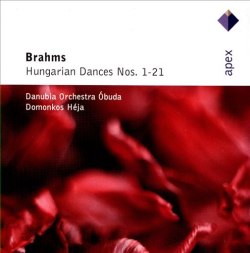| 
|
Johannes BRAHMS (1833-1897)
Hungarian Dances Nos. 1-21
Set 1
No.1 in G minor (orch. Brahms) [3.12]; No.2 in D minor (orch. Johan Hallén, 1846-1925); No.3 in F major (orch. Brahms) [2.06]; No.4 in F sharp minor (orch. Paul Juon, 1872-1940); No.5 in G minor (orch. Albert Parlow, 1824-1888) [2.37]
Set 2
No.6 in D major (orch. Parlow) [3.25]; No.7 in A major (orch. Johann Hallén 1846-1925) [1.44]; No.8 in A minor (orch. Hans Gál, 1890-1987) [3.04]; No.9 in E minor (orch. Hans Gál) [1.41]; No.10 in F major (orch. Brahms) [1.40]
Set 3 - orch. Albert Parlow
No.11 in D minor [2.25]; No.12 in D minor [2.32]; No.13 in in D major [1.38];
No.14 in in D minor [1.57]; No.15 in B flat major [2.54]; No.16 in F minor [2.30]
Set 4 - orch. Antonin Dvořák
No.17 in F sharp minor [2.47]; No.18 in D major [1.25]; No.19 in B minor [1.56]; No.20 in E minor [1.56]; No.21 in E minor [1.23]
Danubia Orchestra Óbuda/Domonkos Héja
rec. Phoenix Studio, Hungary, 21-25 June 2008
WARNER APEX 2564 644431 [52.48]
A tour with the Hungarian violinist Ede Reményi (1828-1898) in 1867 seems to have been the stimulus for Brahms to write his first set of Hungarian Dances. These were for piano duet and were published in 1869. Brahms himself would play several in various recitals in the piano solo versions. They sold well and Clara Schumann was enthusiastic. Some were arranged for violin and piano and Brahms orchestrated three of them.
They are memorably tuneful and although not especially or authentically gypsy or folk-like in style do include catchy and at times syncopated rhythms. Also there’s the use of the augmented second in the often passionate melodic lines, sudden tempo changes, abrupt dynamic crashes and surprises of modulation.
Curiously enough, Brahms orchestrated only three but it left the door open for others to play a hand. It’s a remarkable thing that although four other hands are at work the orchestration is amazingly consistent although for my money Albert Parlow is the more colourful.
I have always felt that Antal Dorati’s recording with the LSO at its best in 1966 would be unsurpassable but in the days of the LP it was rare that all twenty-one dances were made available; Dorati recorded sixteen. It was the later dances of Books III and Book IV published in 1880 that tended to be pushed aside. Indeed whilst listening to Book III I was convinced that the music was new to me. An innovation in these later books was that some dances practically segue into each other, like the last two. In truth it may be that some of them are less melodically memorable but in these days of the CD it is good to have them all together.
Of the orchestrators, Dvořák took on Book IV (the last five), the Russian, Paul Juon orchestrated just number four, Albert Parlow, who composed mostly for the German Navy, took on eight of them. Hans Gál’s surprising orchestrations of Dances Nos. 8 and 9 are slightly rarer. Finally, there’s Andreas Hallén, a now rather forgotten Swedish composer of mainly opera, who is represented by two orchestrations.
As this is a budget price disc there are, as usual with Warner’s Apex series no annotated notes: just the list of dances and speed indications. I can however tell you that conductor Domonkos Héja was born in Budapest in 1974 and certainly grasps the stylistic nuances required to bring the music to life. He is not frightened of rubato although there could possibly have been even more. The blend of the orchestra and tempo variations is deftly handled and the Hungary’s Danubia Symphony Orchestra clearly have this music in their bones. A good example is Number 6 with its teasing opening tempo (actually marked Vivace) which flies into the faster one and back again with flirtatious grace and character. Other tempi, in the later sections are equally sensitively handled until the return of the opening with its mischievous rubato. All quite delightful and, I feel, sort of authentic.
All in all, if you don’t have recording of these dances in your library, and you certainly should have, then at a low price this is as good a place to start as any.
Gary Higginson
 |
 |
|
